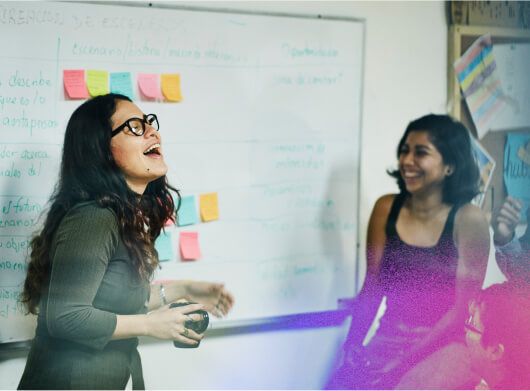Collaboration is a critical part of your company’s culture. And historically, we defined collaboration as coming together in the same room.
But hybrid work has limited how much time we get to spend with one another in the same room. It’s reshaped how we define “collaboration.”
Yet even though most employees want the option to work from home, they also see the office as a place to collaborate and socialize.
“In real life” still matters.
Social momentum
People miss water-cooler conversations, social interactions, and the moments that happen in-between the meetings and deep work.
Spending a day in the office gives you social momentum, which carries you through the days at home that follow.
Frances Brown, Senior Associate at Hoare Lea
Employees are looking to the workplace as a crucial social element that allows them to forge and maintain effective working relationships.
“You can collaborate online,” says Frances Brown, Senior Associate at Hoare Lea, “but it’s not the same as being in the same physical space.”
Initially, remote work was refreshing, Brown tells us. But gradually, it became a challenge to maintain a rapport with coworkers.
“New people joined the team but you’ve never met them in person,” she says. “You’re not quite sure where they’re coming from or what they’re trying to achieve. Spending a day in the office gives you social momentum, which carries you through the days at home that follow.”
Social interaction
We need around six hours of social interaction per day to feel a high sense of well-being. Being social can boost work performance by 25%, improving efficiency and effectiveness, while leading to better decision-making.
To work effectively, we need to socialize.
People now see the office as a place to hit those six hours of socialization. Introverts and extroverts alike seek connection on some level, and the office can help them obtain that at whatever level they are comfortable with.
Creating social experiences
A logical answer to the question, how can I support more collaboration in the workplace, is to create more collaborative spaces.
But there’s more to it than that.
First, not everyone wants to come to the office to collaborate. Removing spaces that support heads-down work would be a critical mistake.
Second, there is not a one-size-fits-all solution to collaborative spaces. From meeting rooms to scrum spaces and lounges, collaboration takes on many shapes and sizes.
By knowing how people use your space (through a combination of both measurement and feedback), you can design based on demand.
Or, you can give employees the power to create the space they need at any given moment.
Twilio, for example, has begun to incorporate a dynamic design into its portfolio to address the evolving needs of its employees.
“We’re calling them dynamic spaces where furniture is reconfigurable,” says Devorah Rosner, Senior Manager of Global Workplace Operations at Twilio, “It’s no longer one-size-fits-all. It allows more variety to meet people where they are, to work how they work.”
To inspire folks to actually come into the office, aim to create experiences that can’t be replicated at home. Because why would anyone come to the office just to sit on Zoom calls all day?
“Show [employees] they’re not just replicating the same day they would have at home, with people sitting next to each other for the same video calls,” Brown notes. “Companies need to actually make it okay for employees to spend time away from their desks, socializing, taking advantage of the shared space to build those invaluable relationships in-person.”
Think hospitality
Consider how you can design your spaces to nurture casual collaboration. And consider how your current design prohibits this.
“When you sit across the desk from somebody, there’s automatically a barrier between you,” says David Shove Brown of //3877. Consider how to remove these overlooked barriers. Shove Brown explains:
“You and I would be sitting in two comfortable chairs right now, sitting across a coffee table, drinking our tea,” he says. “It’s about engagement. There wouldn’t be a desk between us. There wouldn’t be a barrier.”
The office — evolved
Serendipitous encounters are limited when much of the workday is done through asynchronous communication. You don’t bump into people at the water cooler or cross paths in the hallway.
To some extent, this new way of working suffices. People are still productive. They still “show up” to work.
But nearly everyone is yearning to reconnect in real life. Maybe not every day, but they want the option. In other words, the workplace still plays a significant role in the way people work, connect, and thrive.
It’s our responsibility, as workplace leaders, to help our people see the value of the office.
